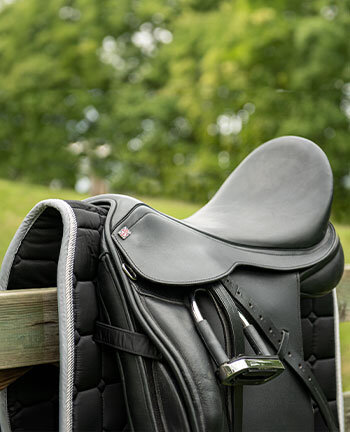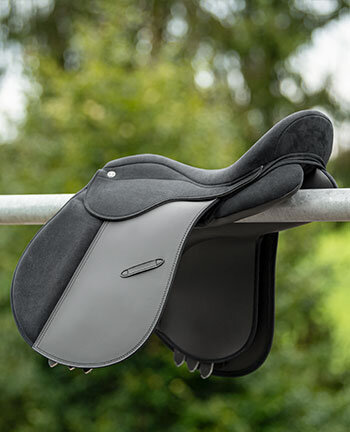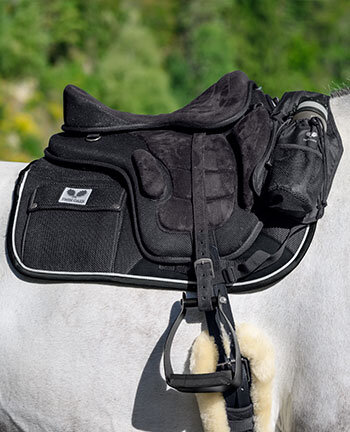- Frequently asked questions
- What types of saddles are there?
- Why is the fit of the saddle so important?
- How does the saddle fit correctly?
Saddles
- Frequently asked questions
- What types of saddles are there?
- Why is the fit of the saddle so important?
- How does the saddle fit correctly?
What types of saddles are there?
- Jumping saddle
- Dressage saddle
- General Purpose saddle
- Trekking saddle
- Western saddle
- Racing Saddle
- Side Saddle
The jumping saddle has a longer seat than the dressage saddle and usually has stronger pommels. To make it easier for the rider to get into the jumping seat, the front and rear gussets are kept relatively flat. In addition, the saddle flaps of the jumping saddle are wide so that the rider has a better hold over the jump when the stirrups are buckled short and the knee is bent. A jumping saddle is usually fastened with a long girth. Some styles have a pronounced belly guard so that the horse does not injure himself on the belly when pulling on his front legs with his shoes.
The general purpose saddle is the all-rounder among the saddles and is a combination of dressage and jumping saddle. It has a saddle flap cut further forward with a pronounced knee roll, so that an general purpose saddle, in keeping with its name, can be used in a particularly versatile way and can meet the basic requirements in dressage, jumping and cross-country riding. It should provide the rider with a good seat for dressage work, offer comfort while hacking and also provide stability and mobility over the jump. There are both dressage- and jumping-oriented general purpose saddles. In our shop you can buy different gullet plate sizes so that you can better adapt your general purpose saddle to the physical changes of your horse.
If you want to go horse trekking and therefore attach great importance to comfort, you can go for a treeless trekking saddle. These adapt extremely flexibly to the shape of the back and the movements of the horse. There are different styles here, consisting of more or less firm layers. With saddles that are as flexible as possible, however, you should bear in mind that the rider's weight is not distributed in the same way as with saddles with a tree. They are more suitable for extensive trail rides in walk than for athletic training. In our online shop you can buy trekking saddles from SHOWMASTER, which are designed with different shapes to meet different requirements.
Why is the fit of the saddle so important?
The saddle is one of the most important pieces of equipment in equestrian sport because it forms the link between horse and rider. Since the horse's back is very sensitive with its spinal processes and long back muscle, the saddle must fit perfectly. On the other hand, individual pressure points occur, which not only cause the horse pain, but also bring about a change in the musculature on and around the back. If the saddle is not adjusted to the shape of the horse's back, the musculature will regress in the corresponding places or the musculature will change over the entire body. This is because every part of the horse's body is connected to each other via fascia and musculature. If there are pressure points due to an ill-fitting saddle, this can have an effect on the muscles of the croup, shoulder or flank. A typical picture of an improperly fitting saddle is, for example, an atrophied trapezius muscle or an incorrectly developed croup musculature.
Other problems that can occur with an improperly fitting saddle are:
- Saddle sores
- Saddle fear/ cold backed"
- Girth galls
- Open sores
- Tension
- White hairs
- Crippled spine
- Inflammations
- Malformation of the muscles
- Regression of the musculature
How does the saddle fit correctly?
For riding to contribute to the horse's health and not harm it, the saddle must fit optimally. In addition to an even distribution of the rider's weight, the freedom of the vertebral canal and the withers as well as the freedom of shoulder rotation play an important role. Under no circumstances should the saddle press on the sensitive spinous processes of the spine. Remember that the saddle and its fit will look different as soon as a rider applies pressure. So check the fit of the saddle both with and without the rider's weight. The following points are important for a correctly fitting saddle:
- There should be 3 to 4 fingers between the withers and the lower edge of the pommel.
- There should be 2 to 3 fingers of space between the withers and the saddle.
- The vertebral canal should have 2 finger widths of space above and 4 finger widths of space in its breadth.
- The angle of the gullet plates should be parallel to the angle of the shoulder.
- The saddle panels should rest evenly on the back.
- The length of the saddle should be between the shoulder blade and the last rib.
- The centre of gravity of the saddle should be central and in line with the centre of gravity of the horse




